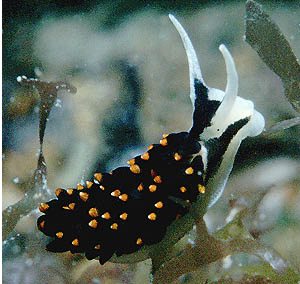
Ercolania cf. boodleae
Order: SACOGLOSSA
Superfamily: LIMAPONTIOIDEA
Family: Limapontiidae
PHOTO
Flinders Pier, Victoria, Australia, January 9, 2002. 2.5m depth. Photo: John Chuk.
Similar in colour to Ercolania boodleae (Baba, 1938). See attached messages for discussion on its identity.
NOTE: This species is most probably Ercolania margaritae Burn, 1974. See discussion below.
Reference:
• Baba,K. (1938) Opisthobranchia of Kii, Middle Japan. Journal of the Department of Agriculture, Kyusyu Imperial University, 6(1): 1-19.
• Burn, R.F. (1974) Notes on some benthonic opisthobranchs from Port Philip Bay, Victoria. J. Mal. Soc. Aust., 3(1): 43-57.
Rudman, W.B., 2002 (February 3) Ercolania cf. boodleae [In] Sea Slug Forum. Australian Museum, Sydney. Available from http://www.seaslugforum.net/find/ercocfbood
Related messages
Ercolania cf boodleae from Victoria, Australia
September 2, 2006
From: Trevor McMurrich
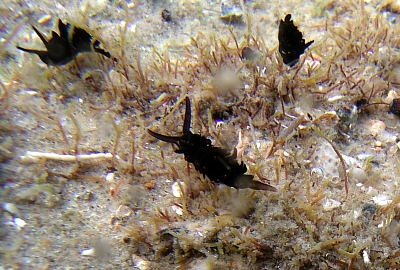

Hi Bill,
I recently found a slug similar to Ercolania cf. boodleae but it was all black with very few orange tips. I was wondering if it is the same species with local colouring or perhaps E. margaritae.
Locality: Portarlington, 1 metre, Victoria, Australia, Port Phillip Bay, 28 August 2006, reef. Length: 10 mm. Photographer: Trevor McMurrich.
I didn't get a very good shot of the slug, sorry about that. I hope it's good enough to make an id.
Kind regards
Trevor McMurrich
trevm@aanet.com.au
McMurrich, T.B., 2006 (Sep 2) Ercolania cf boodleae from Victoria, Australia. [Message in] Sea Slug Forum. Australian Museum, Sydney. Available from http://www.seaslugforum.net/find/17666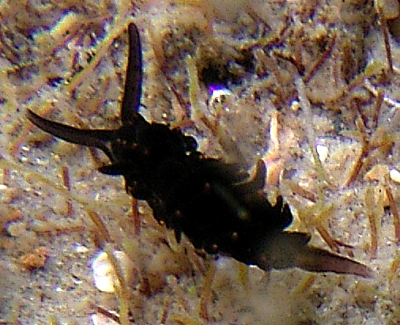
Dear Trevor,
There is nothing wrong with your photos. The two close-ups could well be the photos on the Fact Sheet for Ercolania boodleae, which varies from almost all black to forms with orange-tipped cerata and white on the head. If you have a look at the discussion in the previous messages you will see that we think it is probably that Ercolania margaretae is the balck colour form of Ercolania boodleae, but until someone gets a chance to compare the anatomy of Australian specimens with those from Japan we wiol take the conservative approach and call the Australian animals Ercolania cf. boodleae.
Best wishes,
Bill Rudman
Ercolania margaritae from Victoria
October 9, 2002
From: Joan Hales
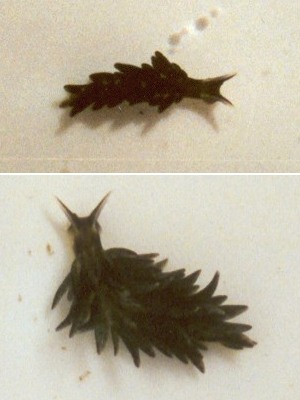
Dear Bill,
Here are some photos of Ercolania margaritae. This was an accidental collection from Walkerville [southeastern Victoria, Australia]). It was not sighted until 19 days after collection when it was about 7mm in length. It was feeding on the Chaetomorpha weed, which I had collected to identify. After one week I rephotographed the specimen. It had grown amazingly in that week, doubling in length and seemingly adding many new cerata. The two photos are both to the same scale.
Joan Hales
Thanks Joan,
The growth information is certainly very interesting. Concernng its identity. It certainly matches the illustrations I have rcently posted of Burn's E. margaritae. What we need to know now is whether this is the same as the species I have on the Forum as Ercolania boodleae. An intersting little project for someone.
Cheers,
Bill Rudman
Ercolania cf. boodleae & E. margaritae
October 6, 2002
From: Cynthia Trowbridge
Dear John and Bill,
The comment about Point Lonsdale reminded me about Ercolania margaritae described by Robert Burn for those high pools you mentioned. There is also an undescribed Ercolania sp. for the region as well. I regret that I do not have the papers available to help distinguish the species. Good luck!
Cordially,
Cynthia
trowbric@ucs.orst.edu
Trowbridge, C., 2002 (Oct 6) Ercolania cf. boodleae & E. margaritae. [Message in] Sea Slug Forum. Australian Museum, Sydney. Available from http://www.seaslugforum.net/find/8111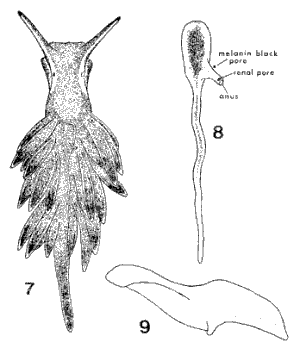
Dear Cynthia,
You are absolutely right about Ercolania margaritae. I hadn't considered it because the cerata were described as black. However in John's latest message he says that in most specimens the cerata are completely black, which would suggest they are Burn's Ercolania margaritae. Burn notes that it is seasonally abundant on the rock platform at Point Lonsdale. He observed egg ribbons in August and September, which he describes as approx 5mm long, 0.6mm diameter, containing a tight spiral of yellow eggs. I guess what needs to be done now is to decide whether E. margaritae is a synonym of E. boodleae.
I have included figures from Burn's (1974) description of Ercolania margaritae.
Fig 8 shows the pericardium, with the chracteristic dorsal vessel and raised anal papilla in the posterior right quarter. Baba & Hamatani (1970) state that in Ercolania boodleae the "anus does not form a papilla, is situated in the anterior region (not in the posterior region as stated in Baba, 1938, p.7) of the pericardial prominence, and opens slightly on the right of the median line". The colour and radular morphology of the two species seems very similar, as does the egg ribbon (Baba & Hamatani, 1952). I am not sure how significant the shape and position of the anal papilla is. If it is important, and the two species prove to be consistently different, Then I guess the animals from Victoria should be recognised as Ercolania margaritae.
• Baba, K. & Hamatani, I (1952) Observations on the spawning habits of some of the Japanese Opisthobranchia. 1. Publications of the Seto Marine Biological Laboratory 2(2): 87-90. (Pl.7)
• Baba, K. & Hamatani, I. (1970) The anatomy of Ercolania boodleae (Baba, 1938) from Seto, Kii, middle Japan (Opisthobranchia: Sacoglossa). Publications of the Seto Marine Biological Laboratory, 18(4): 215-222.
• Burn, R.F. (1974) Notes on some benthonic opisthobranchs from Port Philip Bay, Victoria. J. Mal. Soc. Aust., 3(1): 43-57.
Best wishes,
Bill Rudman
Ercolania cf. boodleae from S.E. Australia
October 4, 2002
From: John Chuk
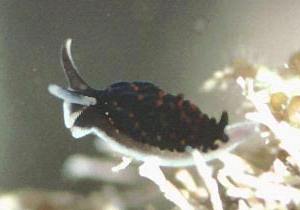
Dear Bill,
Ercolania cf. boodleae has appeared in large numbers in the intertidal zone on the reef at Point Lonsdale, Victoria, Australia. At low tide on 13 Sept 2002 I found about 50 specimens on algal tufts in shallow rock pools on the reef flat. The photo is of a specimen about 6mm in length. It is not a great shot as it was taken from above the water surface in natural light. The specimens were darker in colour and smaller than those I found at Flinders Pier earlier in the year. They were 4mm to 6mm in length. Most had completely black cerata with no hint of colour on the tips. Some, like the animal photographed, had just a hint of red-brown on the tips of the cerata. The black line on the rhinophores extended right to the tip.
These specimens look very similar to the specimens of Ercolania boodleae from Japan. Maybe they are one and the same species? What do you think?
Best wishes,
John.
jchuk@giant.net.au
Chuk, J., 2002 (Oct 4) Ercolania cf. boodleae from S.E. Australia. [Message in] Sea Slug Forum. Australian Museum, Sydney. Available from http://www.seaslugforum.net/find/8109Dear John,
From your description of colour variation, and the photos we now have of animals from Japan I tend to agree that this is Ercolania boodleae. At the moment I am following Kathe Jensen's suggestion that because of the possibility of sibling species we should wait until its anatomy is compared with Japanese material.
Cheers,
Bill Rudman
Re: Stiliger? from S.E. Australia
February 4, 2002
From: Kathe R. Jensen
Dear John and Bill,
This species is indeed very similar to Ercolania boodleae (or to my E. emarginata from Hong Kong, which may be synonymous with E. boodleae). The fact that it feeds on Cladophora shows that it is not Stiliger aureomarginatus, which feed on Codium. Anatomically Ercolania can easily be distinguished from Stiliger in that Ercolania has "sabot-shaped" teeth, Stiliger blade-shaped, and Ercolania has a short curved penial stylet, Stiliger has an unarmed penis.
This find makes it more likely that E. emarginata is synonymous with E. boodleae, which then has a wide West-Pacific distribution. However, I have collected a few specimens of a "sibling" species in Hong Kong, which is almost indistinguishable from E. emarginata (the orange tips of the cerata are missing - but they may also be absent in E. emarginata, depending on its food). This is why I am hesitant to publish the synonymy at the present time.
Cheers,
Kathe
jensen@ait.ac.th
Jensen, K.R., 2002 (Feb 4) Re: Stiliger? from S.E. Australia. [Message in] Sea Slug Forum. Australian Museum, Sydney. Available from http://www.seaslugforum.net/find/6174Thanks Kathe,
The most noticeable external difference I could see was the white rhinophores and foot. Does the known colour variation of E. boodleae encompass forms with this colour pattern?
Cheers,
Bill Rudman
Stiliger? from S.E. Australia
February 3, 2002
From: John Chuk

Dear Bill,
Here are images of a limapontiid I met on a dive at Flinders pier, Victoria, Australia, on January 9, 2002. The species was abundant. I found 18 specimens in a small area at a depth of 2.5m. All but one were on what appeared to be a Cladophora sp. green alga. I did dive the same site at night did not see any specimens.
The rhinophores are simple with an obvious eyespot at their bases. The cerata are black with a small white spot on the tip and a subapical orange band. The orange band is smudged with black. The anterior foot corners are rounded.
The lower right image is of a small specimen (6mm in length) seen feeding on a green alga. The other images are different views of a specimen (12mm in length) found actively crawling over a brown alga (that appears to be Chordaria cladosiphon. This was the largest of all the specimens and the only one not found on the green alga.
I am unable to identify the species but it does have many similarities to Ercolania boodleae. I'd be interested to hear your opinion. In over twenty years of diving at this site this was the first time to find this species. One of the benefits of an interest in opisthobranchs is that no matter how often you dive a site, you never know what will turn up next!
Many thanks for all your help,
John.
jchuk@giant.net.au
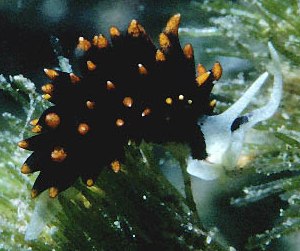

Thanks John,
It certainly has similarities to Ercolania boodleae and also to Stiliger aureomarginatus Jensen, 1993, both of which are essentially black with orange or yellow tips to the cerata. In both species the yellow/orange seems to go right to the tip of ech ceras whereas in your animal it is a distinctly subapical band with a white tip. The other major difference is that in your species the head and rhinophores are white whie in the others they are black.
I would like to hear what Kathe Jensen has to say about this animal. Another interesting find.
Bill Rudman
